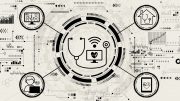The healthcare industry across EMEA has undergone a significant transformation in recent years, with a growing emphasis on digitisation and automation. As technology continues to advance, artificial intelligence (AI) and robotic process automation (RPA) have emerged as powerful tools for improving healthcare delivery and patient outcomes.
However, when it comes to realising the full potential of AI and RPA in healthcare digitisation strategies in the EMEA region, it’s important to recognise both the opportunities and the challenges involved in adopting these technologies.
Fundamentally these are not monolithic, homogenous technologies. The inherent capabilities of AI and RPA mean that they can be applied broadly, in multiple different ways. As such, it is vital that we have a deeper understanding of exactly what these technologies can do, and recognise some of the potential pitfalls, if we are going to see AI and RPA truly revolutionise the industry.
Enhancing efficiency and streamlining processes
One of the primary benefits, and best understood use cases, of AI and RPA in healthcare is their ability to enhance operational efficiency and streamline processes.
For healthcare organisations, there are numerous, repetitive and time-consuming tasks. AI-based machine learning is frequently used for document classification and data extraction to speed invoice turnaround and rapidly index medical records for faster clinician access within the EPR. RPA is also used for activities such as data entry, claims processing and appointment scheduling. By leveraging AI-powered chatbots and RPA solutions, healthcare providers can automate these tasks, allowing staff to focus on more critical and complex responsibilities. This not only reduces the administrative burden but also minimises the potential for human error, leading to improved accuracy and faster processing times.
Improving patient care and outcomes
AI and RPA have the potential to significantly improve patient care and outcomes in the EMEA healthcare landscape.
Through the analysis of large volumes of patient data, AI algorithms can identify patterns, and predict potential health risks. This enables healthcare professionals to provide personalised treatment plans and interventions that are tailored to each patient’s unique needs.
Additionally, AI-powered predictive analytics can help identify patients at higher risk of readmission or complications, allowing healthcare providers to intervene proactively and prevent adverse events.
Enhancing medical imaging and diagnostics
Medical imaging plays a crucial role in diagnosing and monitoring various medical conditions. However, the interpretation of medical images can be time-consuming and subjective. AI are revolutionising medical imaging by automating image analysis and interpretation. AI algorithms can analyse medical images, such as X-rays, MRIs and CT scans, with remarkable accuracy, enabling faster diagnoses and reducing the burden on radiologists. This not only expedites treatment planning but also improves the overall quality of care.
Enabling remote patient monitoring
In the EMEA region, remote patient monitoring has gained significant momentum, especially in the wake of the COVID-19 pandemic. AI and RPA technologies play a crucial role in enabling remote patient monitoring by collecting and analysing patient data in real time.
Wearable devices, such as smartwatches and fitness trackers, can capture vital signs, activity levels and other relevant data points. AI algorithms then can analyse this data, detect anomalies, and alert healthcare providers if intervention is required. Remote patient monitoring not only improves patient convenience but also allows for early detection of health issues, reducing the need for hospitalisations and emergency room visits.
Updating the healthcare experience
In recent years, we have also seen a rise in patient expectations of the healthcare services they are accessing. Influenced by the consumer experience in other sectors, patients increasingly expect slicker, more efficient ways to interact with the healthcare system.
As a result, there is a huge amount of attention currently on generative AI (GenAI). GenAI has the potential to significantly streamline a lot of patient interactions with healthcare providers, increase access to care and even holds out the prospect of keeping patients more engaged with their treatments – with the benefit of further improving outcomes.
Getting the implementation right
However, as healthcare organisations increasingly embrace AI and Robotic Process Automation, there are some vital factors that need to be considered to ensure these technologies don’t fail to deliver on their potential.
Chief among these is the importance of data security and privacy. Patient data is highly sensitive and must be protected from unauthorised access or breaches – without restricting access to medical professionals. Robust cybersecurity measures, including encryption, access controls and regular audits, are imperative to safeguard patient information.
Furthermore, compliance with data protection regulations, such as the General Data Protection Regulation (GDPR) in the European Union, is paramount to ensure patient trust and confidence in the healthcare system.
In developing these solutions, it is also important that IT teams don’t design ‘for the AI’ and instead keep the ultimate users of these systems front of mind. Without considering how these systems will be used by actual humans, there is a high risk that they will fail to secure the engagement of users and to achieve the original goals for building the system in the first place.
And finally, given that most healthcare organisations do not have unlimited funds, it is vital that IT teams focus on the reusability of the AI and Robotic Process Automation systems they are creating. Having to create bespoke, standalone solutions for every use case is not an efficient or cost-effective approach to AI development.
Instead, IT teams should aim to create ‘libraries’ of automation tools that can be easily reused and recombined into other workflows or solutions.
While these implementation challenges are not insignificant, there is a massive incentive to getting deployments on AI and RPA right.
The range of applications for these technologies truly have the potential to transform healthcare in EMEA. From enhancing patient care to freeing up practitioner time, the benefits of optimising processes tasks using AI and RPA are potentially huge – for the leaders of health providers, to frontline workers and, ultimately, patients themselves.
By Alex Ryan, Director, EMEA Healthcare Business Development, at Hyland





